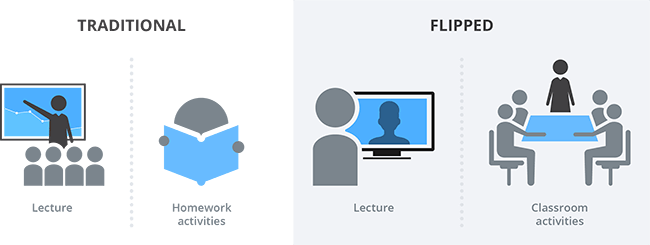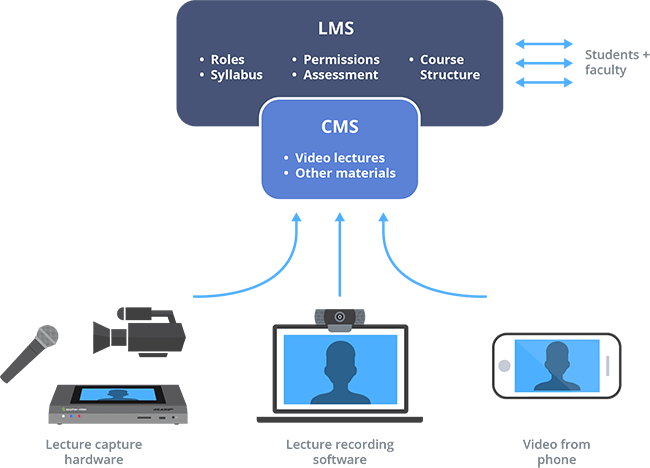Video and other digital resources such as the Khan Academy, TED, Coursera, and many others have become key tools in the student learning process.
In fact, the idea of assigning educational videos as homework and using class time for more non-instructional activities has become a very popular learning format called the flipped classroom. Studies suggest that using the flipped classroom model is able to not only help students learn the course material better, but also help develop valuable life skills, such as leadership, problem-solving, and critical thinking.
What is a flipped classroom?
The flipped classroom instructional strategy reverses the traditional learning environment: Most of the instruction happens outside of class, while practice happens in class. Essentially, this means that in the flipped classroom model video lectures are assigned as “homework,” whereas class time is used for engaging in meaningful discussion, applying learned concepts, and collaborating with peers. Students learn new concepts on their own time, and then check their understanding by doing problem-solving exercises in class with teacher guidance.
It’s not just about watching video lectures at home and doing traditional problem-solving in class. Student assignments often include creating their own video content. This video content could be aimed at self-observation and self-improvement, peer teaching, or even be used as a part of the class teaching material. This form of active learning (aka a type of learning where students do something else besides passively listening to lecture material) is a huge part of the flipped classroom model.

Benefits of the flipped classroom model
As we’ve mentioned, the flipped classroom model can positively impact the development of important life skills in students. The main benefits of the flipped classroom model include:
Accommodation for different learning styles and speeds
Flipped classroom lets each student move at their own pace while learning the material. Platforms like Panopto let the student pause the lecture, rewatch a fragment, and even slow down or speed up the lecture. They can watch it whenever they have time, which can be very beneficial for busy students. Basically, students can have much more control over the way they study.
Building higher-level skills
Because of the way the flipped classroom is structured, students no longer just sit and listen in class. The flipped classroom includes all forms of learning (e.g., oral, visual, listening, hands-on, problem-solving, etc.) and uses a more application-based approach for students. The role of the teacher has changed from presenter of content to learning coach. This new order encourages students to help each other, which promotes collaboration among them. During class time, teachers are also free to spend more time working in small groups or even one-on-one with a student, creating a student-centered learning environment.
High level of accessibility
The flipped classroom is a highly inclusive instructional strategy. Video content is able to reach a lot of people, regardless of their geographic location. Additionally, ADA regulations ask that all educational video content within educational institutions provide closed captioning, making it accessible to an even wider audience.
Encouraging a deeper understanding of the subject
Because the flipped classroom model assumes a lot of active student participation, it’s no longer just about the “covered material.” Understanding the learned concepts and applying them to problems and use cases is what will help students succeed not only in class, but far beyond. After all, “real life” requires us to be much more adaptive and fluid than merely having an academic understanding.
Teaching students responsibility
In the flipped model, class time implies a lot of active learning and hands-on activity. Students must come to class prepared, otherwise they cannot fully participate and hence be graded. Additionally, with assignments involving peer teaching students become responsible for the learning process of others.
Flip carefully!
There are however a few caveats to be aware of when flipping the classroom. First off, the model relies heavily on student motivation: Students have to be responsible enough to watch the lectures and prepare for class on their own. Second, the flipped classroom model assumes a lot of freeform discussion in class, which by nature is quite unpredictable. If the class assessment requirements aren’t clearly set from the start – it may be challenging for the students to understand what they will be graded on at the end. Additionally, if the teacher doesn’t provide enough scaffolding for the learning process, students can begin to feel like they are just teaching themselves.
Educators have to be very careful when first introducing this model of learning to students. It is very important to establish the right culture right off the bat, keeping freeform discussions fairly structured and establishing assessment requirements.
Inspiring examples of the flipped classroom model in action
Traditional flipped classroom
Sociology students taking a hybrid class at Stonehill College receive many of their lecture assignments in the form of video lectures. They are able to access these lectures through the school’s LMS at their convenience to prepare for class. They are able to take notes while watching the video, bookmarking important moments. During class time, students are focused on discussion, problem-solving, and case studies.
Flipping the teacher: peer-to-peer teaching
Law students at USC are divided into small groups and asked to each present a chapter by creating a video presentation. These video files will become supplemental teaching materials for the entire course. Essentially, each group is responsible for teaching one chapter to the rest of the class. The presentation is to include a slide deck and a video of the group speaking. The student groups use lecture capture software to record, edit, and upload their video.
Video conferencing open class and recording for self-monitoring
At the School of Health Sciences at Eastern Michigan University, Professor Frank Fedel uses a flipped-classroom technique to authentically assess and help his students think faster on the spot. Professor Fedel schedules open class hours, asking his students to dial into a conference call. He also asks them to simultaneously begin recording a video of themselves for the duration of the call. During the open class session, Professor Fedel would ask students difficult impromptu questions, which require them to think fast and come up with original solutions on the spot. This simulates a real-life situation for future medical professionals, where emergencies happen all the time. The professor would later review the footage with the students to assess, debrief, and suggest ways to improve the students’ performance.
Video recording for self-observation and comparing
In a Japanese language class at USC students are assigned to make a recording of themselves reading a passage in Japanese. They will then watch a recording of the same passage read by a native speaker to compare and check pronunciation and intonation. Students also upload their recordings to the school’s LMS and receive feedback from the professor.
The tools behind managing massive amounts of video content
By now, this thought may have already crossed your mind: that is a lot of video! Just think about it – even within a single university, there is a multitude of programs and departments, each with numerous courses. Let’s say that each course has its own set of video lectures, and each class has a set of students that needs to have access to those lectures. This just seems like a logistical nightmare.
So, how do schools handle managing, storing, and distributing all the video content?
Theoretically, educators could use a decentralized system, employing a video platform like YouTube and just upload all their videos there. However, YouTube does not offer the level of security or the tools necessary to run a successful flipped classroom. Enter nifty management tools.
LMS, CMS, and AV infrastructure
By “nifty management tools” we mean a combination of three things. First of all, almost every school uses a Learning Management Systems (LMS). An LMS is a software application for the administration, tracking, and delivery of educational courses. Examples of popular LMS include Blackboard, Canvas, and Moodle. Inside every LMS is the second great tool, which is a Content Management System (CMS). CMS stores manage and distribute all content, including video. Examples of such CMS include Panopto and Kaltura. Third, you need a reliable AV infrastructure. By this, we mean everything from laptops to microphones, cameras, tablets, and lecture capture devices.

All three components need to be seamlessly integrated with each other. Additionally, each individual component is largely automated and/or very easy to use. This guarantees fast and simple operation for all the parts involved. This way neither the staff nor the faculty nor the students would have to waste time-fighting with the system.
For example, Panopto CMS integrates seamlessly with Blackboard LMS. Panopto also integrates well with Epiphan’s Pearl family of lecture capture devices. This creates a user-friendly ecosystem that makes creating and delivering video lectures an easy and seamless process.

How it works from the educator’s side:
- Educator prepares and captures the video material for their lecture. For this they might be using video recording software or a hardware lecture capture device like Pearl Mini. The educator may edit the lecture, adding any additional links, quizzes, references, or materials. They could also choose to reuse a previously created lecture.
- They upload the final file to the school’s LMS. A good LMS+CMS combo (e.g., Blackboard + Panopto) makes organizing class folders and upload files simple. Automatically, only the students and faculty in that course or class gain access to these files.
- After the upload is complete, the teacher is able to monitor video lecture statistics. They can see how many students viewed the video lectures, how much time they spent on it, and even which parts were re-watched the most. This way, the educator knows which information was likely difficult for students to understand.
How it works from the students’ side
- The students access their LMS page by logging in using their credentials. Generally, they can do this on any device, at any time. In the portal, they see a list of all their courses, organized by folder.
- They open the corresponding folder to find the video assignment.
- They watch the video, taking notes and completing any quizzes. This information is sent to the faculty automatically.
- Students are also able to create and/or upload their own assignments to the LMS, including completed video assignments.
In conclusion
The flipped classroom model is transforming our learning, teaching, and assessment ecosystems. Now more than ever, students need to develop life skills like critical thinking, leadership, and problem-solving in school. If implemented correctly, the flipped classroom is a model that is able to truly support student success. Learning and content management systems, as well as an excellent AV infrastructure, play a huge role in making flipped classroom successful.
While it’s no doubt that video plays a huge part in the flipped classroom model, it’s not just about being able to watch a lecture from the convenience of your home. More importantly, it’s about being able to spend more class time in meaningful, collective, student-centric activities. Participating in this collaborative, cooperative, and problem-based learning is what will help develop those high-level skills.








